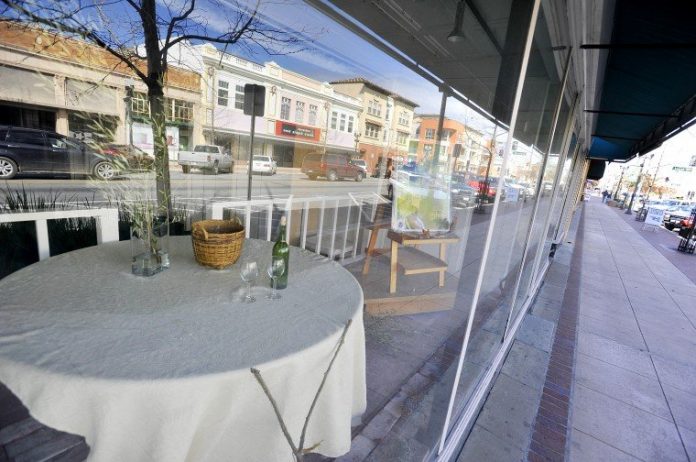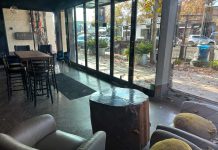
On a recent Tuesday afternoon, shop owner Amber Madrone chatted with customers at Mango Street Kids, a maternity and children’s consignment store on Monterey and Fourth Street. Mango Street Kids, which carries everything from strollers to toys to maternity clothes, was bustling with customers on this particular day – many of whom Madrone seemed to know to by name.
Some came to sell items for store credit, while others came just to browse through the large store.
“I think there is a lot of new momentum in downtown. We’ve got a lot of fresh energy coming in,” Madrone said, pricing fabric baby books as she spoke. “But we have to shift the mentality of our locals. If people don’t come down here, they’ll never see the changes.”
As she spoke, 32-year-old Madrone put price tags on fabric baby books at Mango Street Kids. As a first-time business owner, president of the Downtown Business Association (a group of business owners who promote the downtown district) and a mother of three boys, Madrone is a busy woman.
“Sleep is totally over overrated. But I do love my coffee,” she said, laughing and lifting her thermos up as if to make a toast.
When Madrone got the idea to open a children’s store four years ago, shortly after moving to Gilroy, she knew immediately that downtown was the only place for her.
“To me, downtown is the heart of the community, it’s where you find unique stores and a city’s charm. You don’t get the same feel in a shopping center,” she said.
A baby sat in a car seat near Madrone’s counter, while his mother shopped in the back of the store. Madrone said because the store is in downtown, there is a strong sense of community – so much so that women often leave their babies with her while they shop.
“I’m so glad I opened in downtown,” Madrone said.
Mango Street Kids is one shining example of a healthy business downtown – but empty storefronts are culpable in keeping downtown from progressing.
IS HISTORIC DOWNTOWN HISTORY?
The sun was shining on Monterey Street on a recent weekday in March. Lively music poured out to the street from speakers on lamp posts, and businesses displayed spring decorations in their windows. It was a perfect day for a stroll downtown.
But the sidewalks were practically empty. Not entirely desolate, of course – a man sat alone on a bench, and cars were parked in front of some stores – but on this particular Wednesday, there didn’t appear to be a lot of life in the heart of Gilroy.
Just like the sidewalks, many storefronts aren’t occupied – bearing the sign of the business that once lived in the space, but with a paper sign on the door that prohibits entry.
As president of the Downtown Business Association, a group of business owners who work with city officials to promote the downtown district, Madrone is focused on tackling an issue that she said is downtown’s biggest problem: the unreinforced masonry buildings (URMs), which are deemed dangerous in case of an earthquake.
Madrone said that “things are looking up,” because the city recently relaxed stringent requirements for URM occupancy, making retrofitting more financially realistic for property owners. The city is now requiring property owners to do only the minimal renovations that will prevent the building from collapsing and injuring occupants.
Madrone said these changes will help address what she described as downtown’s great Catch 22: without revenue, property owners don’t have the income to retrofit, but without retrofitting, they can’t get the space rented.
After dealing with the URMs, Madrone said she hopes the business association can start bringing in new businesses.
She said she would love to see downtown as a place where families could come and spend an entire afternoon – one filled with restaurants, bakeries, ice cream stores, coffee shops and specialized retail such as clothing boutiques and antique stores.
And then, there’s the challenge of getting people downtown in the first place. Madrone said that despite downtown having a stigma among locals, when out-of-towners visit her store, they are impressed with how cute downtown Gilroy is.
Melanie Corona, Gilroy’s new part-time downtown business coordinator, said that once downtown is known for its events, such as the wine stroll in May, the summertime car show and more, locals will start to change their minds about downtown.
“It just needs a chance,” Corona said. “Residents need to put aside anything negative they’ve heard about downtown and just come check it out.”
Corona said in the future, downtown will be the place to be in Gilroy. Her goal this year is to run successful events downtown, and to partner with the city to continue to revitalize the district.
Tarra Garcia, manager of Scotty’s Restaurant at Gilroy Bowl on Monterey and Fifth streets, has been a Gilroyan since 1967 and has witnessed the rise and fall of downtown first-hand.
“I’m not ready to give up on this downtown,” Garcia said. “I really think it can be something good.”
Garcia said that people in Gilroy need to take pride in their downtown.
“I don’t go to Morgan Hill,” she said. “The few dollars I have I spend in Gilroy.”
QUICK FIX FOR NOW
Susan Valenta, president of Gilroy’s Chamber of Commerce, said that downtown is worth fighting for.
“We are privileged to be a part of something that has evolved for a few centuries,” Valenta said about the downtown historic district.
“Once a city loses their downtown, it’s extremely difficult to get it back,” she said.
Valenta said that before the recession, downtown was on the rise. New businesses were coming in. Renovations were being done. But when the Great Recession hit in 2008, everything came to a halt.
Now in the midst of revitalization, Valenta said that the city is doing what they can to incentivize business, but they can only do so much to spur development – the other part has to come from the property owners.
“We’ve all tried really hard to bring these folks to the table,” Valenta said about the property owners of URM buildings. But because many of them have owned the buildings for decades and live outside Gilroy, Valenta said that it is an “out of sight, out of mind,” issue.
Valenta said that some owners just left plywood, netting and portable toilets in their empty storefronts.
The URMs and empty storefronts aren’t going to disappear overnight. So the city of Gilroy came up with an interim plan.
All owners of empty downtown buildings are now required to dress their storefronts with either local art or faux window decor to make the building look occupied. Faux window dressings must contain the “visual characteristics of a vibrant business,” such as a colorful table bountiful with plastic hamburgers and fruit, or an aesthetic display of shoes and handbags, to give the people walking through the illusion of a thriving downtown.
The ordinance, which was passed by city council in February, is a small step in getting the city to combat the blight of empty stores.
“I think if it were turned, and it was their neighborhood we were talking about, they’d expect the same thing,” Valenta said.
Valenta said that she doesn’t see downtown ever becoming Santana Row – the upscale shopping and dining complex in San Jose – because that’s just not Gilroy’s culture.
Tammy Brownlow, president of Gilroy’s Economic Development Corporation agreed, saying that Gilroy’s downtown is more unique and is “certainly not a cookie cutter.”
And downtown is a bigger employer than some might think, Brownlow said. In 2009, 530 people were employed in a small section of downtown, she said, between Fourth Street and Sixth Street, spanning from Eigleberry Street to Railroad Street.
BRINGING IN FRESH ENERGY
Some of the “fresh energy” that Madrone talked about came in the form of young, enthusiastic storeowners such as Phillip Willis and Tiffany Smith, owners of Dragonfly on Fifth (formerly Sue’s Coffee) on Monterey and Fifth, and Sandra Castaneda, 30, co-owner of Amoretto Boutique on Eigleberry Street and Fifth Street.
Amoretto’s, which carries an aesthetic array of jewelry and handbags, opened a year-and-a-half ago. Castaneda said that despite foot traffic being low, business has been “pretty good.”
Castaneda opened the store because she said she thought Gilroy needed more unique stores for “fashionable young moms,” who don’t have time to drive to San Jose.
“I’m a mom, so I know what it’s like,” Castaneda said. “I wish there were more shops like this in downtown.”
In October, the Gilroy Welcome Center moved from their relatively dead location just north of the downtown core to the Premium Outlets, where they get about 20 times the amount of visitors than they had downtown, said Jane Howard, Welcome Center director.
People come from all over to shop at the Outlets, Howard said, so the Welcome Center’s new location can reach more people than its former location which had low foot traffic. But the goal is still to direct people to downtown, as well as all the other things that Gilroy has to offer beyond the Outlets, Howard said. The move, she said, has proved to be successful.
In October to December 2010, when the Welcome Center (then called the Visitor’s Bureau), was near downtown, Howard had 346 walk-in visitors. In October to December 2011, after moving to the Outlets, it saw 7,000. (The Welcome Center also increased their hours from five days a week to seven.)
Howard offers visitors maps of downtown, as well as a Garlic-heavy cuisine tour of Gilroy, which have several downtown stops.
In December 2011, the Welcome Center distributed 2,284 brochures and visitors maps of Gilroy.
Howard said that when people go to downtown for an event, such as a wine stroll, they go into shops they didn’t even know existed.
“We just need to get people down there for a reason,” she said.
Howard also said that downtown needs to focus on their customer service, because that is how it can outshine the many other shopping centers in Gilroy with retail giants like Walmart and Target.
“Mike from the (downtown) vacuum store has an incredible following, and it’s because of his service,” Howard said. She said Mike knows what his regulars need before they ask.
Howard said she would like to see learning opportunities for downtown businesses – that might even include a secret shopper evaluation – to partner with business owners and give them marketing tips. Perhaps getting the businesses to stay open later, even just once a week, would be a step in the right direction, she said.
“Once a week, that’s all I’m asking,” Howard said, laughing. “Any baby step is good.”
Howard said that she thinks the city, business owners and locals have begun to team together to fight for downtown.
“It’s definitely not hopeless,” she said. “I think there is a strong, renewed sense that downtown is going to make it.”
A Day in Downtown
– Get your Java on at Dragonfly on Fifth. They roast their own beans, and there is ample seating and free Wifi. (Try the homemade chocolate lava cakes too.)
– Shop for relics at the many unique antique stores.
– Lunch at Garlic City Cafe or Scotty’s at Gilroy Bowl.
– Lots of options for dinner – Station 55 with live music, the Milias for a glass of local wine and a steak, or authentic Mexican cuisine at Cielito Lindo.
– If you are a nightcrawler, head to Desero Tequila Town and grab a margarita (or two), and dance.














